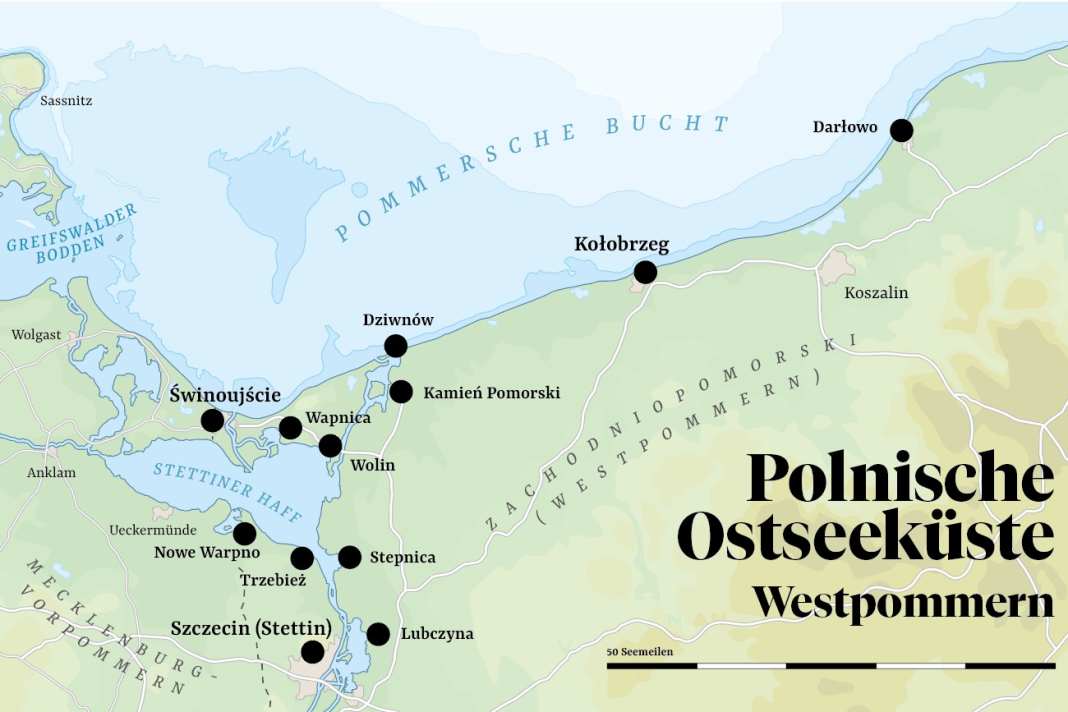




The series:
- West Pomerania: Poland's West - Part 1: Szczecin Lagoon
- West Pomerania: Poland's West, Part 2 - the Oder
- West Pomerania: Poland's west, part 3 - the Baltic coast
Kamień Pomorski (Cammin)
Legend has it that the devil once wanted to throw a huge block of granite at the town's cathedral. However, thanks to heavenly providence, the stone missed its target and landed in the Zalew Kamieński (Camminer Bodden).
As a result, the town with its 9,000 inhabitants has not only preserved one of the country's most important architectural monuments. Kamień Pomorski also benefited from the expansion of the West Pomeranian Sailing Route, through which a modern marina with cafés, sauna and bistros. It offers 290 permanent and 20 guest berths with a pool depth of 2.50 metres.
The half-timbered houses and the late Gothic town hall in the vicinity of the marina have been restored. The old harbour, about 400 metres to the west, has also been converted into a nautical centre and now offers a wide range of services. In the immediate vicinity, the Ryby Zubowicz excellent fish dishes.
Dziwnów (Dievenow)
The lively seaside resort stretches over a six-kilometre-long spit at the mouth of the River Dziwna into the Baltic Sea. Similar to Kamień Pomorski, this marina was also built as part of the expansion of the sailing route in West Pomerania. The harbour is semi-circular and well protected, with a basin depth of 3.5 metres and space for 60 guest berths and twelve permanent berths (Tel.: +4 89 13 81 12 35).
Downstream in the direction of Zalew Kamieński, a 16-metre-long lift bridge spans the Dziwna, which was put into operation in 1994. There is a petrol station about half a kilometre below the bridge that supplies water and land vehicles with fuel.
Kołobrzeg (Kolberg)
Sea, salt and mud baths: at the end of the 19th century, Kołobrzeg (Kolberg) was one of the leading health resorts in Europe. The former Hanseatic and episcopal city, whose mighty fortifications even gave Napoleon a run for his money, is now the largest and most popular spa town in Poland, despite the destruction of the Second World War and the difficult post-war period. Long sandy beaches, hotels of all categories as well as luxurious spa and wellness facilities are the most important economic factors in this town of 47,000 inhabitants, alongside the professional fishing industry.
The water sports industry in West Pomerania has also moved with the times. A good kilometre from the mouth of the Parsęta (Persante) into the Baltic Sea located marina with a view of the historic warehouses, offers space for a total of 250 boats around the small Redoute Morast fortress (basin depth between 2 and 3 metres). The sanitary and service facilities are modern, and the marina's own restaurant is good value for money.
Darłowo (Rügenwalde)
Darłowo (Rügenwalde) is the easternmost town in the Zachodnio-Pomorskie voivodeship and therefore also the end point of the West Pomeranian Sailing Route as seen from Świnoujście. The town of 12,500 inhabitants has a baroque old quarter and a Gothic castle.
Darłowo (Rügenwalde) is connected to the seaside resort of Darłówko (Rügenwaldermünde), three kilometres away, by the 112-kilometre-long Wiepraza (Wipper) river. Once founded as Prussia's first seaside resort, Darłówko today has a well-protected fishing and commercial harbour. Its basin is adjoined by a modern marina with a water depth of 4.5 metres and 41 permanent and 15 guest berths.
West Pomerania: Nautical literature
Sea charts
- Delius Klasing sports boat charts set 13: "Poland and Lithuania", 5 over-sailors, 17 area and detailed charts plus area guide with area information and waypoint list including 47 harbour plans and 1 year licence for use as a digital chart, edition 2024/25, 89.90 EUR.
Cruising guide
- "Baltic Sea coast 2. from Wismar to Szczecin", 9th edition 2024, 232 p. 39,90 EUR
Travel guide
- Szczecin, Swinoujscie and Wollin Island". Via Reise Verlag, 5th edition 2023, 192 pp, 16.95 EUR
- "Polish Baltic coast. Swinemünde to Kolberg". Via Reise Verlag, 3rd edition 2024, 168 p, 16.95 EUR.
- "Poland. Baltic coast and Masuria". Reise Know-How Verlag, 7th edition 2024/25, 600 p, 23.90 EUR Website of the Polish Tourist Board: www.polen.travel/de
Internet presence of the Zachodniopomorski Szlak Żeglarski (Sailing route from West Pomerania)

